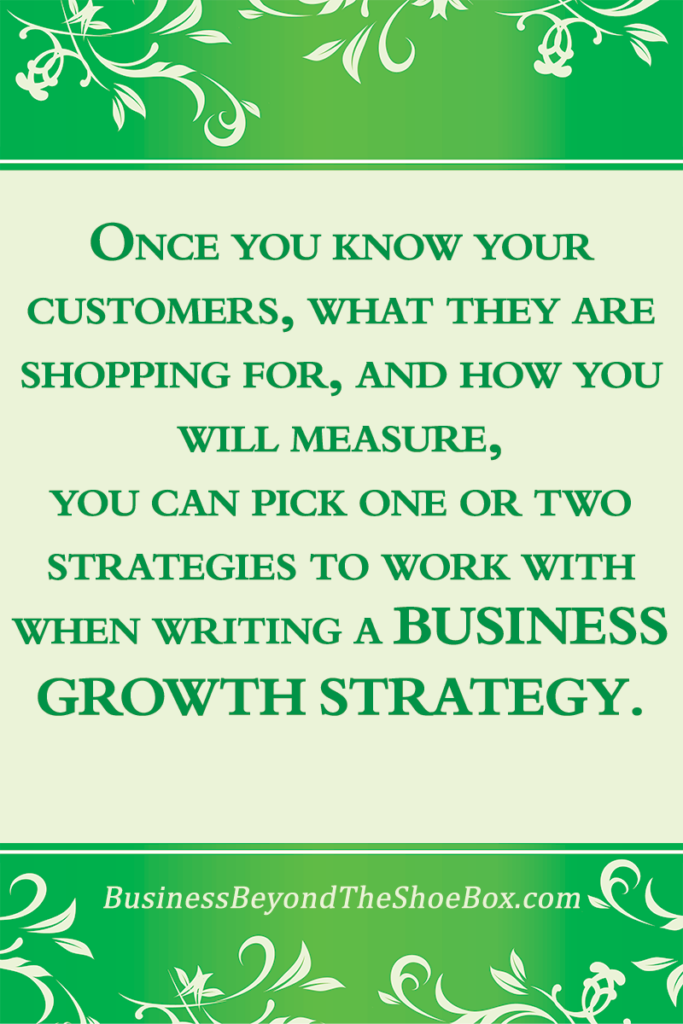It’s true, I love helping people start a small business. BUT… I love helping people write a business growth strategy even more. Why? A business growth strategy gives people the most potential to succeed. While it can be used by new or established businesses, it’s something only proactive business owners look for and this enthusiasm for their business is exciting. If you’re dedicated to your small business, keep reading!
What is a Business Growth Strategy?
Sadly, a business growth strategy is often not well developed in most business plans and also frequently deferred as business owners focus on marketing thinking this is their only path to success. A growth strategy focuses more on revenue generation while concurrently looking at the market, your customers, and your competition. If you don’t already have a business plan, I suggest starting with one before proceeding to a growth strategy. Click here to download my 5-page business plan guide. The business growth strategy is an important part to the framework of your business plan. The most common growth strategies are market penetration, market expansion, product development, diversification, and customer acquisition. If you don’t know what these terms mean, learn them. They are keystones to success.
A Business Growth Strategy Starts With Knowing Your Customers
Knowing your USP (Unique Selling Position) will factor into many aspects of your business growth strategy and your USP is based on your customers. Modern customers expect a customer-centric strategy based on their wants and needs, so… do you know the wants and needs of your customers? More importantly, do you know the 3-6 benefits they shop for? We all shop based on benefits over features. And while you may think you know your customers, they are the ones who ultimately decide how to spend their dollar. It is on you to really know their fears, expectations, and desires, which should all be based on the benefits they get from your services and/or products.
Next, Look at How You Will Measure Your Growth
Measuring your growth is important and you’ll want to decide on your KPIs (Key Performance Indicators) before starting to write your growth strategy. A common measure is customer acquisition – where your customers are coming from. If you know you get 10 customers per month through Google, that could be one of your KPIs to measure growth. Another common KPI is sales per product/service per month. If you know you sell 10 widgets and 5 gizmo cleaning services per month, you’ll be able to measure results. If you want to measure off of your revenue, I strongly suggest knowing your financial floor first. It was the smartest thing I ever did for my business.
Once you know who your customers are, what they are shopping for (the benefits), and how you will measure, you can pick one or two strategies to work with.
Product Development, Market Penetration, and Market Expansion
At this point, you can start considering your share of the market. By knowing who your customers are, you can estimate how many potential customers there are. Then ask yourself if there are enough potential customers to grow your business through market penetration. If there are enough customers, you’ll want to look at market penetration and examine your competition. Think about where your customers hang out and look for ways to set yourself apart from your competition. If there are not enough customers in your target region, it’s time to consider product development and market expansion. If you sell a service in San Luis Obispo, you could expand to North County, South County, or even Santa Barbara to maximize your market’s reach. But if your niche is small, it might be time to add to your products or services which will be guided by those benefits your customers are hungry for. This can also be turned into a spiral revenue strategy by offering them more products or services that branch off of what they initially purchase; like selling paper and adding the sale of printers, ink, and then shredders. And while it might be easy to say “I can sell all over the world,” you want to keep in mind how much of your budget is available for marketing, so as a business consultant, I coach my clients on picking target regions one at a time.
Diversification
New products are one way to diversify for growth, but attracting a new niche of customers is yet another way. If your paper was always organic, diversification of non-organic paper would attract an entirely new set of customers who are shopping on entirely different benefits. The risk with diversification is always the risk of breaking your brand; those organic paper shoppers might look down on a company that sells paper not sourced in an eco-friendly way and shop elsewhere. However, diversification can be done correctly if you know your customers and it is often the next strategy businesses use after they have good market penetration – to the point of market saturation.

Putting Your Growth Strategy into Action
Once you’ve written out your strategy, it’s time to put it in action. I tell all of my clients to put it on their calendar; make appointments with yourself to put in the time you need to research development, and marketing to start hitting your new goals. Don’t be stopped by this feeling hard. As you spend some time with doing the work it will feel more comfortable and confident. You’ve got this.





